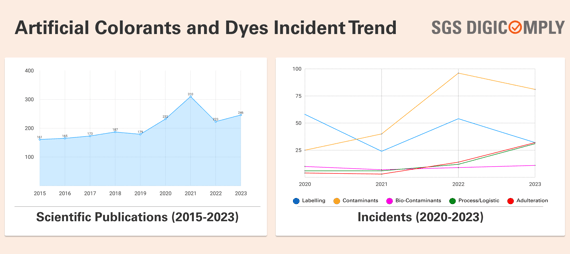The use of artificial colorants and dyes in bakery products has long been a common practice to enhance visual appeal and consumer attractiveness. These additives, which are synthetically derived, are employed to impart vivid and attractive colors to various baked goods, including bread, cakes, pastries, and cookies. However, concerns have been raised about their potential impacts on food safety and human health, necessitating a comprehensive assessment of their safety profiles and associated risks.
Chemical Composition and Types of Artificial Colorants and Dyes
Artificial colorants and dyes encompass a broad spectrum of chemical compounds utilized in bakery products. These include azo dyes, which are commonly employed due to their stability and wide color range, anthocyanins derived from fruits or vegetables, carotenoids such as beta-carotene, and various other synthetic pigments. Each compound possesses unique chemical properties influencing factors like color stability, solubility, and heat resistance.
Regulatory Frameworks and Guidelines
Governmental regulatory bodies, such as the Food and Drug Administration (FDA) in the United States, the European Food Safety Authority (EFSA) in Europe, and other international agencies, oversee the approval and usage of food additives, including artificial colorants and dyes. These organizations set strict regulations, including permissible levels of usage, conduct risk assessments, and continuously monitor scientific data to ensure consumer safety.
Labeling Regulations and Consumer Awareness
Regulatory bodies mandate clear and accurate labeling of food products, including bakery items containing artificial colorants and dyes. Food manufacturers are obliged to list these additives by their specific names or E-numbers in the ingredients list. This transparency allows consumers to make informed choices, especially for individuals with known sensitivities or allergies to certain colorants.
Nutritional Information and Transparency
In addition to ingredient lists, nutritional labels on bakery products provide crucial information regarding the content of artificial colorants and dyes. Nutritional facts highlight the quantity of additives present in the product, aiding consumers in assessing their intake levels and making informed decisions about their dietary choices. Manufacturers are encouraged to provide comprehensive information, enabling consumers to manage their consumption based on personal preferences or health considerations.
Safety Evaluation and Health Concerns
Several scientific studies have explored the potential health risks associated with the consumption of products containing artificial colorants and dyes. Concerns have been raised regarding allergic reactions, particularly in susceptible individuals. Moreover, some studies have suggested a possible link between certain synthetic colorants and hyperactivity in children, as well as potential carcinogenic effects. However, the conclusive evidence regarding these risks remains inconclusive and subject to ongoing debate within the scientific community.
Technological Advancements and Risk Mitigation Strategies
The field of food technology continuously explores innovative approaches to mitigate potential risks associated with artificial colorants and dyes in bakery products. Encapsulation techniques, which involve enclosing the additives within a protective shell, have shown promise in enhancing stability and reducing adverse effects. Additionally, the exploration of natural alternatives derived from plant-based sources is gaining traction as a safer alternative to synthetic colorants.
Analytical Techniques for Detection and Quantification
Accurate detection and quantification of artificial colorants and dyes in bakery products are crucial for regulatory compliance and consumer protection. Sophisticated analytical techniques such as high-performance liquid chromatography (HPLC), mass spectrometry, and spectroscopic methods are employed to precisely identify and quantify these additives, ensuring adherence to safety standards.
SGS Digicomply Insights: Risks and Trends Analysis of Incidents Related to Artificial Colorants and Dyes
In analyzing trends of incidents related to Artificial Colorants and Dyes in the Digicomply APP, we aim to underscore several potential risks and urge companies to leverage the latest technological advancements and risk reduction strategies as they directly impact incident rates.

While the trend of scientific publications and research in this field continues to grow, the incident rate in 2023 experienced a slight surge, raising concerns that it may persist. It is crucial to note that as of 2020, approximately 73% of all incidents were labeling violations, indicating the strictness of regulatory bodies concerning this matter. However, in 2023, over 50% of all incidents are directly associated with contamination, necessitating additional safety verification protocols.
Hence, it is imperative to continue exploring this domain and implementing best practices, risk reduction strategies, and technological advancements such as SGS Digicomply. By analyzing millions of data sources, solutions like SGS Digicomply assist market leaders in preempting risks and complying with regulatory requirements. Explore SGS Digicomply platform now.
Conclusion
The assessment of food safety impacts arising from the utilization of artificial colorants and dyes in bakery products is a multifaceted endeavor that requires a comprehensive understanding of their chemical compositions, regulatory oversight, potential health concerns, and technological advancements. While these additives contribute significantly to product aesthetics, ongoing research, stringent regulation, and the exploration of safer alternatives remain imperative to safeguard consumer health and well-being.





.webp?width=1644&height=1254&name=Food%20Safety%20Dashboard%201%20(1).webp)
